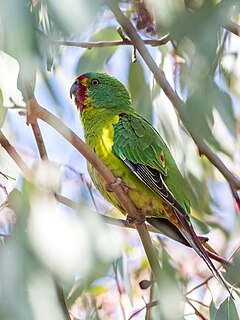
The swift parrot is a species of broad-tailed parrot, found only in southeastern Australia. The species breeds in Tasmania during the summer and migrates north to south eastern mainland Australia from Griffith-Warialda in New South Wales and west to Adelaide in the winter. It is a nomadic migrant, and it settles in an area only when there is food available.

Handfish are any anglerfish within the family Brachionichthyidae, a group which comprises five genera and 14 extant species. These benthic marine fish are unusual in the way they propel themselves by walking on the sea floor rather than swimming.

Brachionichthys is the type genus of the handfish family Brachionichthyidae. Originally, all species of handfish were included in Brachionichthys, but researchers have since split species off into five additional genera.

The gummy shark, also known as the Australian smooth hound, flake, sweet william or smooth dog-shark, is a shark in the family Triakidae. These small to medium-sized bottom-dwelling sharks are found mostly in, but are not limited to, the area around the southern seas of Australia and is commonly baited and fished for cuisine because of its taste and market prices. According to a 2021 paper by White, Arunrugstichai & Naylorn (2021), Mustelus walkeri is the same animal as M. antarcticus. One theory is that M. walkeri is a subpopulation of M. antarcticus.
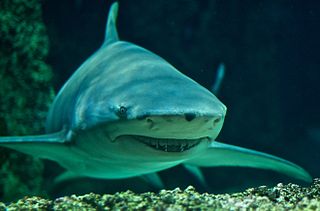
The sicklefin lemon shark or sharptooth lemon shark, is a species of requiem shark belonging to the family Carcharhinidae, widely distributed in the tropical waters of the Indo-Pacific. It is closely related to the better-known lemon shark of the Americas; the two species are almost identical in appearance, both being stout-bodied sharks with broad heads, two dorsal fins of nearly equal size, and a plain yellow-tinged coloration. As its common name suggests, the sicklefin lemon shark differs from its American counterpart in having more falcate (sickle-shaped) fins. This large species grows up to 3.8 m (12 ft) long. It generally inhabits water less than 92 m (302 ft) deep in a variety of habitats, from mangrove estuaries to coral reefs.

The speartooth shark is a rare species of river shark, belonging to the family Carcharhinidae. It inhabits coastal marine waters and tidal reaches of large tropical rivers in northern Australia and New Guinea. Despite being a member of the river shark genus, it is also found in near-shore marine waters, favoring highly turbid environments over a wide range of salinities. This robustly built, gray-colored shark is characterized by a short and broad snout, tiny eyes, a relatively large second dorsal fin, and a black blotch beneath each pectoral fin near the tip. Another identifying trait is its teeth, which are large, triangular, and serrated in the upper jaw and narrow, spear-like, and serrated only near the tips in the lower jaw. Adults grow to about 2.6 m (8.5 ft) long.
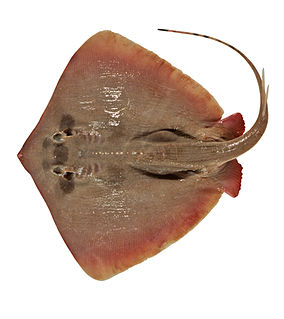
The plain maskray or brown stingray, is a species of stingray in the family Dasyatidae. It is found in shallow, soft-bottomed habitats off northern Australia. Reaching 24 cm (9.4 in) in width, this species has a diamond-shaped, grayish green pectoral fin disc. Its short, whip-like tail has alternating black and white bands and fin folds above and below. There are short rows of thorns on the back and the base of the tail, but otherwise the skin is smooth. While this species possesses the dark mask-like pattern across its eyes common to its genus, it is not ornately patterned like other maskrays.

The crossback stingaree or banded stingaree is a species of stingray in the family Urolophidae. It is endemic to southeastern Australia, mainly off Victoria and Tasmania but also marginally to New South Wales and South Australia. This bottom-dwelling fish generally inhabits sand and reef habitats deeper than 100 m (330 ft) off Victoria, and muddy habitats in shallow bays and estuaries off Tasmania. Befitting its name, the crossback stingaree has a distinctive dark pattern on its back, consisting of a midline stripe that is crossed by three transverse bars. It has an oval pectoral fin disc with a blunt snout and a skirt-shaped curtain of skin between the nostrils. Its tail is short with no skin fold along the sides, and a deep, leaf-shaped caudal fin. The youngest rays may have a small dorsal fin in front of the stinging tail spine. This species reaches 50 cm (20 in) in length.
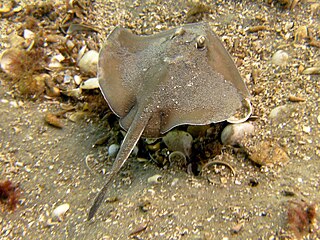
The sparsely-spotted stingaree, also known as the white-spotted stingaree or Dixon's stingaree, is a species of stingray in the family Urolophidae, common off the southern Australian coast. Preferring sandy flats and seagrass beds, this benthic ray can be found from close to shore to a depth of at least 150 m (490 ft), and tends to occur deeper in the northern portion of its range. Reaching a length of 57 cm (22 in), this species has a broad, diamond-shaped pectoral fin disc that is typically plain gray in color above with a V-shaped marking between the eyes. Individuals from southerly waters also generally exhibit a smattering of small, dark-edged white spots. This ray is further characterized by a distinctively bell-shaped curtain of skin between the nostrils. Its tail has a skin fold running along either side and a leaf-shaped caudal fin, but no dorsal fin.

Theodore Wells Pietsch III is an American systematist and evolutionary biologist especially known for his studies of anglerfishes. Pietsch has described 72 species and 14 genera of fishes and published numerous scientific papers focusing on the relationships, evolutionary history, and functional morphology of teleosts, particularly deep-sea taxa. For this body of work, Pietsch was awarded the Robert H. Gibbs Jr. Memorial Award in Systematic Ichthyology by the American Society of Ichthyologists and Herpetologists in 2005. Pietsch has spent most of his career at the University of Washington in Seattle as a professor mentoring graduate students, teaching ichthyology to undergraduates, and curating the ichthyology collections of the UW Burke Museum of Natural History and Culture.

Brachiopsilus is a genus in the handfish family Brachionichthyidae.

Thymichthys is a genus in the handfish family Brachionichthyidae. Like other handfishes, they move by means of walking on their pectoral fins, which resemble hands.
Sympterichthys is a genus in the handfish family Brachionichthyidae with these species:
Gerald Robert "Gerry" Allen is an American-born Australian ichthyologist. His career began in 1963, when he spent a semester at the University of Hawaii, where he also received a PhD in marine zoology in 1971. In 1972, Allen wrote his doctoral thesis on the systematics and biology of the anemone fish.
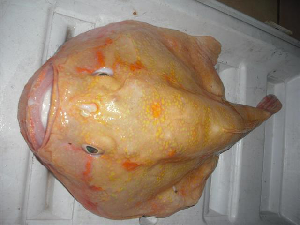
The coffinfish is a species of sea toad of the family Chaunacidae, which consists of 17 species. It is found in salty temperate waters of southwestern Pacific, off east coast of Australia. The coffinfish was first discovered around February 1997 in Sicily, Italy by the skipper of the Libra, which was a trawler who was harbored in Mazara at the time. It can be also found in depths of 164–984.3 ft (50.0–300.0 m). Deep sea crab fishermen off the east coast of Florida pull them up from depth ranging from 5,000-8,000 feet about 54–68 miles off the coast. They have a globose and spiny body that grows to a maximum length of 22.0 cm (8.7 in) and a black mouth lining and an illicium on the snout that can be lowered into a groove.

The Tasmanian numbfish is a species of electric ray in the family Narcinidae. Endemic to southeastern Australia, this common ray inhabits shallow continental shelf waters in the southern portion of its range and deeper continental slope waters in the northern portion of its range. It prefers sand and mud habitats. This species can be identified by its spade-shaped pectoral fin disc with concave anterior margins, long tail with well-developed skin folds along either side, and plain dark brown dorsal colouration. Its maximum known length is 47 cm (19 in).
Tasmania can be broadly divided into two distinct regions, eastern and western, that exhibit major differences in climate, geology and vegetation. This divide, termed Tyler’s Corridor, runs from just south of the northwestern corner, and continues south, cutting roughly down the center of the island. The vegetation changes occur principally due to variations in soil types, which are a result of the geological composition, and the vast difference in climate across the state. Generally, the west has a higher mean rainfall but poor acidic soil while the east has a lower mean rainfall but slightly more fertile soil. This results in a larger proportion of rainforest, moorland and wet sclerophyll vegetation dominating in the west and predominantly dry sclerophyll in the east.
Peter Colin Young is a British-born ichthyologist and parasitologist who spent most of his career in Australia. From 1995 to 1997, he served as President of the Australian Society for Fish Biology.

The red handfish is a species of handfish in the genus Thymichthys, found in Frederick Henry Bay, Tasmania.
Moulton's handfish is an endangered species of handfish in the genus Sympterichthys. It is endemic to a few locations off the southeastern coast of Australia. It was first described as a distinct species in 2009 by Peter Last and Daniel Gledhill. It lives at a depth of around 105 metres (344 ft) - 150 metres (490 ft).













